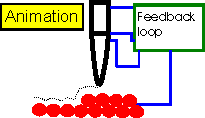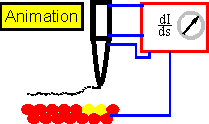
|
Up to now homogoneous surfaces were considered. If there is an inhomogeneous
compound in the surface the work function will be inhomogeneous as well. This alters
the local barrier height. By using the two modes described above we would get
a virtual hole or adatom. But this can further be explored: Differentiation of (*) yields  . . Thus the work function can directly be measured by variing the tip-sample distance, which can be done by modulating the current with the feedback turned on. |

|

